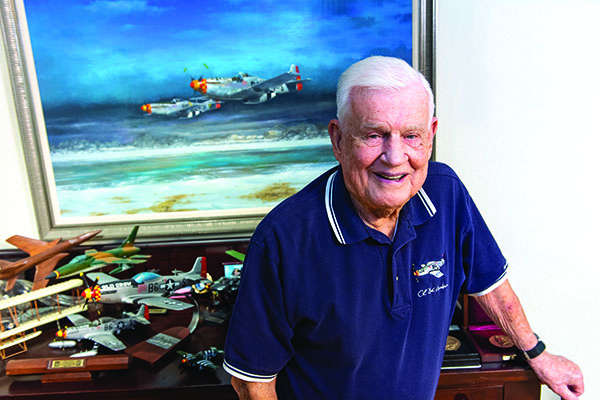Fighter pilot Colonel Clarence E. “Bud” Anderson, 96, is a triple ace, credited with 16.25 enemy kills in the skies over Europe. In P-51B and P-51D Mustangs he named “Old Crow,” Anderson flew two tours and 116 combat missions with the 363rd Fighter Squadron, part of the Eighth Air Force’s 357th Fighter Group, based at Leiston, England. One of only a handful of pilots to fly in World War II, Korea, and Vietnam, he is the coauthor (with Joseph P. Hamelin) of the 1990 book To Fly and Fight: Memoirs of a Triple Ace. He lives in Auburn, California—not far from the farm in Newcastle where he was raised—and continues to be a popular public speaker.
How did your war begin?
I went through flight school in September of 1942 and immediately went to the San Francisco Bay Area to the replacement pilot training group at Hamilton Field. We had duty at the Oakland Municipal Airport; we took over the old flight terminal and lived right there on the base at the airport. We had a bunch of P-39 Airacobras and got checked out there. The idea was that about three months later we would be attached to some combat unit somewhere in the world. Of course, we wondered where that was—would it be North Africa or the South Pacific?
And instead…
When my three months were up, they said, “Oh, no, you’re not going right now. You guys are going to a brand-new fighter group that’s being activated.” We would be the very first members of that group—the 357th. I didn’t realize it at the time, but that meant a lot of good things for me. It made me a flight leader, which was good for promotions. But the big deal was it gave me a whole new training cycle for flying formations, gunnery, dogfighting—all the things you do training for war. That was a big advantage because it gave me more experience. The more experience you have, the better off you are.

Did you know from the beginning that you would be flying the P-51?
No, we learned that around the time we left Casper, Wyoming—our last base before we arrived in England. I can’t remember exactly when it was, but it was a great surprise.
What training did you get?
We had never even seen a P-51, let alone flown one. We had the great pleasure of checking the Mustang out in the theater. We didn’t even have a handbook [chuckles].
How tough was that?
Well, back then fighters were all pretty much the same. What we trained in—the P-39—made it pretty easy to transition to the P-51. And the P-51 was so much better that we were absolutely delighted to have it. In England, they were taking them off the boats, assembling them, and getting them into the air. You found a crew chief to help you start up the plane, then you flew it back to base [laughs]. It was not as bad as it sounds. You know, I could make it sound really terrible, but it was a good deal for us.
It sounds like your group was one of the first to fly the P-51.
We were the second unit in the Army Air Forces to get the Mustang and the first one with them in the Eighth Air Force. After they found out how good it could be, the Eighth Air Force demanded more P-51s. They had had nothing but P-38s and P-47s in 15 fighter groups. By the end of the war, the fighter groups were all P-51s except one.
Do you remember your first kill? What was the first plane you shot down?
Oh, yeah [laughs]! Very much! An Me-109. I was the flight leader, of course. We were starting to get kills and I hadn’t gotten one. On that day, we had just been relieved by another fighter group; I had a flight of four and we were heading home at fairly high altitude when another flight from another squadron in our group joined up with me. I see this B-17 up ahead of us way down low. So I told the guys, “Let’s go there and cover him to the water, at least.” As we are heading toward him, here come three Me-109s off to our right with their bellies up, turning in to go after the B-17—and they obviously didn’t see these seven or eight P-51s coming.
And then?
I said [chuckles], “Goldarn, one of these is mine, because I’m leading this outfit.” So I picked one guy out and I got into a circling dogfight with this 109 by myself. But I just couldn’t get on his tail. I’m maneuvering, trying to get at his six o’clock, and I just can’t do it. He’s coming at me at a very high angle—not shooting but trying to get on my tail.
I had shot quail as a kid, so I knew all about leading with a gun. I said, “Alright, next time when I come around if I can’t get this guy, I’m going to get him lined up, and pull [inside of his circle] very, very tightly—so much so that I won’t be able to see him. He’ll be under my belly off in the distance.” So I pull through to get enough lead to shoot ahead of him and fire a fairly long burst. Sure enough, when he comes into sight, his plane is streaming coolant. I thought, “Oh, boy, I got ’em! The golden bullet!”
What happened to the pilot?
He pulled up and bailed out immediately.
So I’m sitting there kind of cheering to myself and all of a sudden I feel the presence of something and I look out and here’s a guy right on my wing—another Mustang from the other squadron. He had his mask off and was grinning. It was John England; he already had a couple kills. He was giving me a big “Okay” sign. I go: “Goddamn, did he shoot this thing from under me?” Then I thought, “Oh, what the heck. Maybe he’s congratulating me.”
I just couldn’t figure it. By the time I got home, I had convinced myself I probably hadn’t shot this guy down; it had been John England. I filled out the paperwork and told the intelligence officer to hold it until I talk to somebody. So I head over to the officers’ club; it’s where we all met after a mission to have a few drinks and talk about the day’s fight. And I’m thinking, “How am I going to bring this up?” So I decide I’m just going to walk in—and he is over at the corner bar. He sees me and comes running over and says, “Andy, that’s the greatest shot I’ve ever seen! You shot that sucker down at over a 60-degree angle.” So I rubbed my chest with my fingers and said, “You know, Johnny. Lucky shot.” Then I rushed to the phone and claimed my first victory.
To what do you attribute your success as an ace?
You need good instincts. To be an ace, you have to shoot down five enemy aircraft in aerial combat—in air-to-air, one-versus-one, kill-or-be-killed situations. The difference between a good fighter pilot and a great one, I think, is good eyesight. I had 20-15 in one eye and 20-10 in the other. Even if you have good eyes, there’s a knack to finding airplanes off in the distance. You can maneuver into a position of advantage if you see them first. You also have to have good gunnery skills, have knowledge of enemy airplanes, and know how to dogfight. Situational awareness is a big deal as well. You have to know what is going on all around you, listening to radio calls, looking and doing and maneuvering.
I heard Old Crow was named for the whiskey. True?
Well, I tell my nondrinking friends that it was named after the most intelligent bird that flies in the sky. My drinking buddies all know that it was named after that good old Kentucky straight bourbon. It was the cheapest thing back then.
Did you ever think about the danger you were in?
No, not at 22 years old. It’s a big adventure—certainly the most exciting thing I have done in my life. We say we are doing it for country and all that stuff but, you know, in good combat units, mostly you are doing it for each other. It’s camaraderie. As far as that goes, we were just trying to get through one day at a time.
It must have been difficult when you lost friends.
Yeah, I lost half of our original squadron, either killed or taken POW. That’s the tragedy of World War II—the great loss of human life. You read any history book and our historians can’t even agree within a million how many people died during that war: 40 to 45 million people, and one book said 70 million people died. Those are numbers I can’t comprehend.
It’s mind-boggling.
Yeah. And the Eighth Air Force—just one of 17 U.S. air forces—lost more killed than the entire Marine Corps for the war. Just one air force. When you think of casualties, you tend to think of the army and the Marines—Iwo Jima, D-Day, the Battle of the Bulge—but the Eighth Air Force started fighting in 1942 and had casualties of something like 40,000-plus. Another terrible statistic is the Army Air Corps was trying to build up their pilots as fast as possible, going from a few thousand to 125,000 pilots. We lost more pilots in training than we did in combat.
I’m sure in wartime they were considered acceptable losses.
[Chuckles] I always wondered what “acceptable losses” meant. It was acceptable so long as it wasn’t you!
You are rated to fly more than 100 airplanes. Do you have a favorite?
Well, I got a handful of them. I liked the P-51, of course. It got me through the war. It’s a beautiful airplane that has a special sound to it. It was also a good airplane and it made significant contributions to the war. In Korea, I flew the F-86 Sabre. Same thing: a great plane that never surprised you. It was beautiful and I loved to fly it. After I retired, I got a front-seat ride in an F-15 Eagle and, I’ll tell you, that is something else! The new airplanes fly great because they are flown through computers. You can program in the general characteristics, so they all fly good, I guess, but I know the Eagle does! My fourth favorite is the F-16 Fighting Falcon. I got a back-seat fly in that plane. It has a sidestick control [a joystick-style controller, typically to the pilot’s left side, used to control the airplane rather than a conventional yoke or “stick” directly in front of him]. I had never really done that before, so that was fun to play with. Once you flew it for a little bit, you felt very comfortable with it. That was a surprise.
What does it mean to you to be America’s highest-scoring living ace?
What it means is I just survived longer than the others. ✯

this article first appeared in world war II magazine
Facebook @WorldWarIIMag | Twitter @WWIIMag





